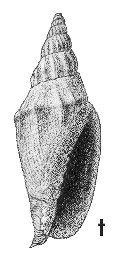
Revised descriptions of New Zealand Cenozoic Mollusca from Beu and Maxwell (1990)

 | Revised descriptions of New Zealand Cenozoic Mollusca from Beu and Maxwell (1990) | 
|
  (Pl. 21t): GS9520, J41/f8029, Awamoa Creek, Oamaru, Altonian (GNS) |
Beu & Maxwell (1990): Chapter 11; p. 206; pl. 21 t.
Synonymy: Alcithoe lepida Marwick 1926a, p. 296; Alcithoe reflexa Marwick 1926a, p. 296-7; Alcithoe neglecta Marwick 1926a, p. 298; Alcithoe separabilis Laws 1932, p. 194; Leporemax lepidus; Leporemax neglectus; Alcithoe (Leporemax) lepida, Beu & Maxwell 1990, p. 206, pl. 21t.
Classification: Volutidae: Zidoninae
Description: Size small to moderate for subfamily (height 50-80 mm), fusiform, spire 0.35-0.4 total height. Protoconch mamillate, of 2 squat whorls with feeble spiral threads. Teleoconch of 5-6 whorls, first whorl lightly convex, later whorls broadly angled at or near middle on spire, sutural ramp flat or gently concave; last whorl unexcavated or broadly and shallowly excavated. Axial sculpture of narrow, low costae reaching from suture to suture on first 2 or 3 whorls but becoming obsolete on ramp, and in most shells restricted to peripheral nodules or tubercles with little or no anterior extension on later whorls, but in a few shells becoming obsolete; 12-15 nodules on penultimate whorl. Spiral sculpture retained on well-preserved shells as feeble threads or grooves. Aperture narrow, constricted posteriorly; anterior notch broad, moderately deep, fasciole almost flush. Columella almost straight, somewhat padded near middle in some shells, bearing 5 or 6 narrow plaits, the anteriormost considerably weaker than the others. Inner lip callus a thin smear in some shells, but much thicker in others. Outer lip slightly thickened, extending almost up to peripheral angulation, only weakly reflected in most shells.
Comparison: The holotype of Alcithoe reflexa differs from typical A. lepida in having much weaker axial sculpture on spire whorls, and a more conspicuously reflected outer lip, but these differences are unlikely to be taxonomically significant. The holotype of A. neglecta is smaller, more robust and lower-spired than most specimens of A. lepida, but it closely resembles the latter in protoconch size, whorl shape, sculpture and columellar plaits and is not considered to be a distinct taxon. A. separabilis was distinguished from A. lepida on the basis of several minor differences, including its larger size and concave sutural ramp, but none are sufficiently compelling to warrant its taxonomic separation. A. scopi (Target Gully Shellbed, Oamaru, Altonian; also Awamoa Creek), however, does seem to be a different species, distinguished from A. lepida by its larger protoconch (although protoconch size varies considerably in both species), its less strongly shouldered teleoconch whorls, by having less conspicuous axial sculpture on adult whorls (typically costae rather than peripheral nodules) and in having a narrower anterior notch. A. finlayi (Target Gully Shellbed, Oamaru, Altonian) also seems to be distinct — it differs from both A. lepida and A. scopi in being consistently tall-spired (although some specimens of A. lepida are equally tall-spired), in having a very shallow anterior notch and a thin outer lip, and in having only four columellar plaits. Beu & Maxwell (1990) selected the name Alcithoe lepida for the species named A. lepida, A. reflexa and A. neglecta by Marwick (1926a).
Leporemax has been used in the past as a subgenus to include volutes resembling Alcithoe in general appearance but of considerably smaller size and rather more slender shape. However, molecular phylogeny has demonstrated that Recent species assigned there, such as A. fusus (Pl. 49i), are nested within typical Alcithoe species. Size alone evidently is not a guide to relationships within Alcithoe.
Distribution: Otaian-Altonian; Ardgowan Shellbed, Oamaru, Altonian (type locality of A. lepida and A. separabilis); Pukeuri, Oamaru, Altonian (type locality of A. reflexa); Target Gully Shellbed, Oamaru, Altonian (type locality of A. neglecta); Awamoa Creek; Old Rifle Butts, Cape Wanbrow; Bluecliffs, Otaio River; Weka Creek.
Cite this publication as: "A.G. Beu and J.I. Raine (2009). Revised
descriptions of New Zealand Cenozoic Mollusca from Beu and Maxwell (1990). GNS
Science miscellaneous series no. 27."
© GNS Science, 2009
ISBN
978-0-478-19705-1
ISSN 1177-2441
(Included with a PDF facsimile file
copy of New Zealand Geological Survey Paleontological Bulletin 58 in CD version
from: Publications Officer, GNS Science, P.O. Box 30368 Lower Hutt, New
Zealand)